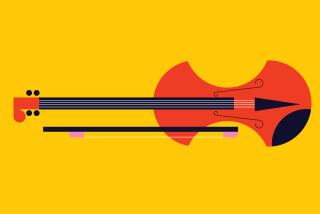‘There are more myths in this violin stuff than you can shake a stick at.’
- Share via
Violin maker Raymond Wise plies his trade in a setting that seems perfectly suited to his romantic occupation. He works out of the historic Quon Building, one of San Diego’s oldest, and reputedly one of the mainstays of the colorful “Stingaree District” in the city’s early days. Inside his tiny, brick-walled studio, freshly carved violins share wall space with horse tails, which are used for stringing the instruments’ bows. But Wise, 51, eschews the grandiose pretensions of the great European violin makers, insisting that his is an all-American pursuit, with no mystique attached. Times staff writer Leslie Wolf interviewed Wise at his studio, and Bob Grieser photographed him.
There are quite a few independent violin makers around the country like myself, but as far as I know I’m the only one here in San Diego trying to make a living out of making violins.
There are more myths in this violin stuff than you can shake a stick at. In the past, the violin makers sort of encouraged all kinds of tales, like about secret varnishes and secret places to get the wood to make excellent violins. It’s really all a lot of hogwash.
I’ve been at this about 10 years. I was in the Navy, as a steam engineer, before I went to work in a big violin shop in San Diego as an apprentice for six years. Not too many young people go into this because really it takes about 10, maybe 15 years before you start making any money on it. Sometimes, you have to do a lot of repairs and don’t have enough time to make instruments. I’m not getting rich, but I keep my head above water.
The most expensive violins are the rare old Stradivariuses--they’re a quarter-million dollars and up. A lot of the lesser Italian ones will go for up to $80,000 or $90,000. It’s about $5,000 to $10,000 for the French and German ones.
Unlike a piano, which usually gets bad with age, a violin sounds better with age. Some of them are 200 or 300 years old and still going strong. They sound just super.
There’s a lot of myth about that man, Antonio Stradivarius. He was no superman; he just consistently made a good product. He didn’t invent violins or anything; he was just a very steady maker. Some make great violins, but they’re erratic.
Stradivarius lived in the golden age of violin-making in the late 1600s, right around the same time as the Amati and the Guarnerios families. They all lived in Italy, right in the same 100-year period. After that, violin-making sort of died off and a lot of the old ways were lost.
Nowadays, a lot of superb makers have fallen by the wayside because they have to make the violins faster in order to make a dollar. That’s a terrible thing, but that’s the way it goes. If you want an artistic instrument, you’re going to have to spend about a year.
The reason they cost so much is that, if you’re doing skilled work, you want to get a minimum of $10 to $15 an hour. I’ve spent up to $300 on a hunk of wood just for the backboard. So, if you’re going to make nice handmade violins, you have to ask for $2,500 minimum just to make a living.
There are a lot of factory violins made. Now, they’ve got a lot of machinery that will carve the whole thing, and it will look more perfect than I can do, but they kind of look machine-made. You can always tell the difference. Some makers will buy pre-carved parts and touch them up the way they want them.
There’s a little piece of wood inside a violin that connects the front and back, called the sound post. The French call it the soul of the violin because it influences the sound so much. You can move it just a tiny bit, and it can change the sound a lot.
Some guys are called sound post and bridge wizards, and if you really know how to fine-tune a bridge, you can make a lot of money just adjusting violins. Frankly, I think it’s a bunch of hocus-pocus.
When people buy a violin, they don’t look at the sound first, they look at how it looks. If a person can make a really artistic violin, to heck with the sound. It’s recognized throughout the violin world that, if you get two violins and they both sound good, of course they’re going to take the prettiest one.
More to Read
The biggest entertainment stories
Get our big stories about Hollywood, film, television, music, arts, culture and more right in your inbox as soon as they publish.
You may occasionally receive promotional content from the Los Angeles Times.










